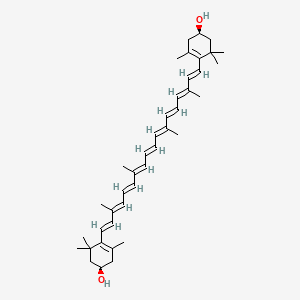Zeaxanthin
Zeaxanthin is a lipid of Prenol Lipids (PR) class. Zeaxanthin is associated with abnormalities such as Disintegration (morphologic abnormality), Alkalemia, Age related macular degeneration, Visual impairment and Consumption-archaic term for TB. The involved functions are known as Signal, Regulation, Energy Transfer, Process and Pigment. Zeaxanthin often locates in Chloroplast thylakoids, reaction center, Tissue membrane, PSII associated light-harvesting complex II and Thylakoid Membrane. The associated genes with Zeaxanthin are PRB2 gene, Structural gene, Polypeptides, Genes, Bacterial and Genes, rRNA. The related lipids are Membrane Lipids, Micelles, Fatty Acids, Lipid Peroxides and monogalactosyldiacylglycerol. The related experimental models are Knock-out.
References related to lipids published in Others
| PMID | Journal | Published Date | Author | Title |
|---|---|---|---|---|
| 11729205 | J. Biol. Chem. | 2002 | Ruban AV et al. | Activation of zeaxanthin is an obligatory event in the regulation of photosynthetic light harvesting. |
| 21106934 | FASEB J. | 2011 | Amengual J et al. | A mitochondrial enzyme degrades carotenoids and protects against oxidative stress. |
| 17932304 | Plant Physiol. | 2007 | Havaux M et al. | Zeaxanthin has enhanced antioxidant capacity with respect to all other xanthophylls in Arabidopsis leaves and functions independent of binding to PSII antennae. |
| 26016861 | Am. J. Clin. Nutr. | 2015 | Kim JE et al. | Effects of egg consumption on carotenoid absorption from co-consumed, raw vegetables. |
| 25483230 | Arch. Biochem. Biophys. | 2015 | Bovier ER and Hammond BR | A randomized placebo-controlled study on the effects of lutein and zeaxanthin on visual processing speed in young healthy subjects. |
| 26482868 | Free Radic. Biol. Med. | 2015 | Olchawa MM et al. | Zeaxanthin and α-tocopherol reduce the inhibitory effects of photodynamic stress on phagocytosis by ARPE-19 cells. |
